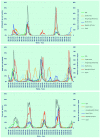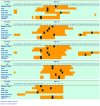Comparison of influenza surveillance data from the Republic of Korea, selected northern hemisphere countries and Hong Kong Special Administrative Region SAR (China) from 2012 to 2017
- PMID: 33936854
- PMCID: PMC8053902
- DOI: 10.5365/wpsar.2019.10.2.015
Comparison of influenza surveillance data from the Republic of Korea, selected northern hemisphere countries and Hong Kong Special Administrative Region SAR (China) from 2012 to 2017
Abstract
Influenza surveillance is conducted in many countries; it is one of the most important types of infectious disease surveillance due to the significant impact and burden of the influenza virus. The Republic of Korea has a temperate climate, and influenza activity usually peaks in the winter as in other temperate-climate countries in the northern hemisphere. This descriptive study compared the influenza surveillance data from the Korea Centers for Disease Control and Prevention with that from other countries and areas in the northern hemisphere, namely China, including Hong Kong Special Administrative Region SAR, Japan and the United States of America, to identify seasonal influenza patterns from 2012 to 2017. Data on influenza-like illnesses (ILIs) and laboratory surveillance were collected from various sources; visual comparisons were conducted on the onset, duration and the peak timing of each influenza season based on subtypes. Correlation coefficients were estimated, and time differences for the beginning of influenza seasons between the Republic of Korea and other countries were measured. ILIs in North China and cases reported from Japan's sentinel surveillance showed high correlations with the Republic of Korea. The number of confirmed influenza cases in Japan showed a high correlation with the laboratory-confirmed influenza cases in the Republic of Korea. We found that there are similarities in the influenza patterns of the Republic of Korea, Japan and North China. Monitoring these neighbouring countries' data may be useful for understanding influenza patterns in the Republic of Korea. Continuous monitoring and comparison of influenza surveillance data with neighbouring countries is recommended to enhance preparedness against influenza.
(c) 2020 The authors; licensee World Health Organization.
Figures
Similar articles
-
Assessing the impact of COVID-19 interventions on influenza-like illness in Beijing and Hong Kong: an observational and modeling study.Infect Dis Poverty. 2023 Feb 16;12(1):11. doi: 10.1186/s40249-023-01061-8. Infect Dis Poverty. 2023. PMID: 36797765 Free PMC article.
-
Forecasting seasonal influenza-like illness in South Korea after 2 and 30 weeks using Google Trends and influenza data from Argentina.PLoS One. 2020 Jul 16;15(7):e0233855. doi: 10.1371/journal.pone.0233855. eCollection 2020. PLoS One. 2020. PMID: 32673312 Free PMC article.
-
Possible interference between seasonal epidemics of influenza and other respiratory viruses in Hong Kong, 2014-2017.BMC Infect Dis. 2017 Dec 16;17(1):772. doi: 10.1186/s12879-017-2888-5. BMC Infect Dis. 2017. PMID: 29246199 Free PMC article.
-
Prevalence, burden, and clinical management of migraine in China, Japan, and South Korea: a comprehensive review of the literature.J Headache Pain. 2019 Dec 5;20(1):111. doi: 10.1186/s10194-019-1062-4. J Headache Pain. 2019. PMID: 31805851 Free PMC article. Review.
-
A review of the surveillance systems of influenza in selected countries in the tropical region.Pan Afr Med J. 2014 Oct 1;19:121. doi: 10.11604/pamj.2014.19.121.4280. eCollection 2014. Pan Afr Med J. 2014. PMID: 25745529 Free PMC article. Review.
Cited by
-
Clinical analysis of influenza in the neonatal intensive care unit.Ital J Pediatr. 2024 Sep 18;50(1):184. doi: 10.1186/s13052-024-01742-6. Ital J Pediatr. 2024. PMID: 39294774 Free PMC article.
References
Publication types
MeSH terms
LinkOut - more resources
Full Text Sources
Medical
Miscellaneous



